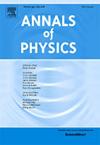广义相对论二阶耗散流体力学:不同阶张量的耦合
IF 3
3区 物理与天体物理
Q2 PHYSICS, MULTIDISCIPLINARY
引用次数: 0
摘要
在这项工作中,我们扩展了二阶相对论耗散流体动力学的形式,该形式先前使用Zubarev的非平衡统计算子形式(Harutyunyan et al., 2022)。通过采用流体动力梯度的统计算子的二阶展开,我们证明了由于不同等级张量之间的两点量子相关器的耦合,在不同的时空点上进行评估,出现了新的二阶项。这些项的出现是因为系统中加速度矢量的存在使得支配对称约束的居里定理得以扩展,从而可以从不同时空点的不同阶张量构造不变量。新术语是在一套完整的二阶方程的背景下确定的,这些方程控制着以能量-动量张量和多个守恒电荷为特征的一般量子系统的剪切应力张量、体粘性压力和电荷扩散电流。此外,我们确定了与这些新项相关的输运系数,并推导了通过两点和三点相关函数表示二阶输运系数的Kubo公式。本文章由计算机程序翻译,如有差异,请以英文原文为准。
Generalized relativistic second-order dissipative hydrodynamics: Coupling different rank tensors
In this work, we extend the formalism of second-order relativistic dissipative hydrodynamics, developed previously using Zubarev’s non-equilibrium statistical operator formalism (Harutyunyan et al., 2022). By employing a second-order expansion of the statistical operator in terms of hydrodynamic gradients, we demonstrate that new second-order terms emerge due to the coupling of two-point quantum correlators between tensors of differing ranks, evaluated at distinct space–time points. Such terms arise because of the presence of the acceleration vector in the system allows Curie’s theorem, which governs symmetry constraints, to be extended for constructing invariants from tensors of different ranks evaluated at distinct space–time points. The new terms are identified in the context of a complete set of second-order equations governing the shear-stress tensor, bulk-viscous pressure, and charge-diffusion currents for a generic quantum system characterized by the energy–momentum tensor and multiple conserved charges. Additionally, we identify the transport coefficients associated with these new terms and derive the Kubo formulas expressing the second-order transport coefficients through two- and three-point correlation functions.
求助全文
通过发布文献求助,成功后即可免费获取论文全文。
去求助
来源期刊

Annals of Physics
物理-物理:综合
CiteScore
5.30
自引率
3.30%
发文量
211
审稿时长
47 days
期刊介绍:
Annals of Physics presents original work in all areas of basic theoretic physics research. Ideas are developed and fully explored, and thorough treatment is given to first principles and ultimate applications. Annals of Physics emphasizes clarity and intelligibility in the articles it publishes, thus making them as accessible as possible. Readers familiar with recent developments in the field are provided with sufficient detail and background to follow the arguments and understand their significance.
The Editors of the journal cover all fields of theoretical physics. Articles published in the journal are typically longer than 20 pages.
 求助内容:
求助内容: 应助结果提醒方式:
应助结果提醒方式:


